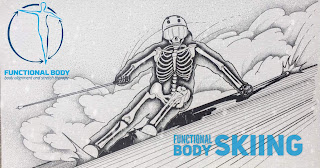Hips for better grip
 |
| A movement like this requires refined joint awareness to keep my balance. |
For example: When creating higher edge angles are you really moving laterally with your thigh bones or more tipping with the lower part of your spine? It would be good to know this yes? With each season I am personally gaining greater awareness of the 360 joints in my body by training my body awareness. I started out getting in touch with some of the major ones used in skiing first and am now at the stage of refining things such as my eyes, elbows, scapulas and skull. I still come back to the basics and check in with them daily. To give you an example I spent roughly 90 days one winter just thinking about how my hips moved in the fore and aft plane and in all conditions all turn shapes. Two joints, one plane of motion, but over a variety of conditions, turn shapes and speeds.

So if you're up for it I'd like you to try a simple self awareness assessment to see how in tune you are with your hips. For this post we are going to assess the hip joints in the lateral plane only.
 |
| Mr Bones Shifting his Pelvis left in the lateral plane. |
So lets define where our hips are first. The hip joints are the ball and socket joints on the sides of our pelvis. The ball is the end of your thigh bone and the socket is part of your pelvis. Standing with our feet hip width apart, let's shift our pelvis to the left as far as we can before losing our balance. Standing between a doorway can help you have a target to hit with your pelvis. This being the left side of the doorway. As we shift our pelvis laterally to the left, moving our private parts out beyond our left foot we should feel the inside of the left thigh gets closer to our groin. The opposite should occur on the inside of your right thigh. It opens away from your groin as the right leg stays planted on the ground. Closed space on the inside of the left, open space on the inside of the right. Does this happen clearly in your body? Try and keep the rest of your body quiet so you can fully focus on feeling these two joints move. We want to tune in and note in a detailed way how good our awareness is of moving just the hip joints.

Try shifting your pelvis to the right. We should feel a lateral opening of the left inner thigh and a lateral closing of the right inner thigh against the pelvis. Does this happen the same on both sides? Do you get as much range? Does one side feel tighter? Do you need to twist on one side versus the other?
 |
| It's much easier to see lateral movements from behind and visualise where the pelvis and legs are. |
Why is this a worthwhile exploration of your body awareness? Well, spending some quality time focused on how the hip joints move could be what you are missing in order to stay balanced in a short turn, gain better grip against the snow, take strain off your knee joint or compression of your lower back. The hips play a major role in balancing lateral movements in skiing. We need lateral hip movement for balancing against the edges of our skis. Our hips give us the most amount of range in the lateral plane than any other joint. Just think of the splits to see this. If we don't have the awareness of our hip joint movement and the mobility in this area then either our body will limit how far we can go or it will use another set of joints to do the job. Ideally all our joints contribute to a movement which results in load and force being spread throughout the system. When one joint moves less another joint will try and make up for it. If we can become more aware of our joint movements then we take control of how we use them.
So powerful and here's why; You can now A) watch a video of yourself and look for the movements of the hips, B) see if the joints are moving or not, C) use your awareness to create a change on the next run and compare to see if there is a difference!
 |
| Henrik Kristofferson displaying great lateral balance. Inside hip is closed outside hip is laterally open |
So just remember 360 joints. That's a full circle. A complete revolution. We have just explored two. Your hips and their motion laterally. Stay tuned for more joint exploration in skiing.
Thanks
Tom Gellie
Body Alignment Coach and Instructor Trainer
www.functionalbody.com.au


Comments
Post a Comment